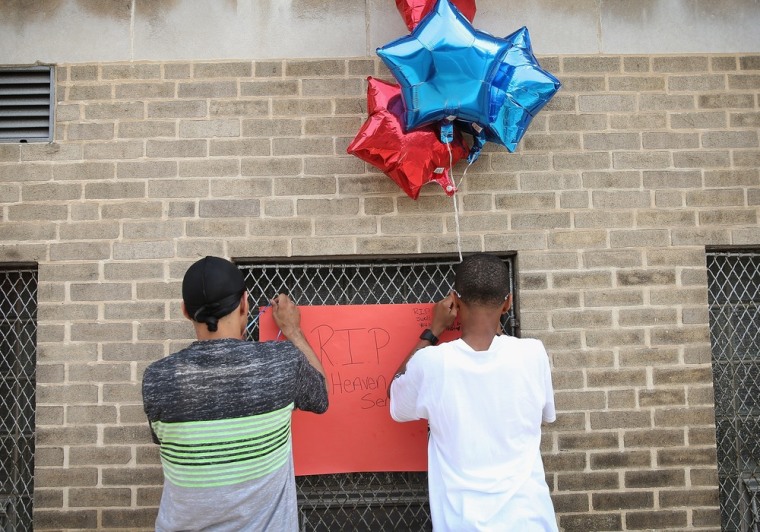Murder rates for children, teens and young adults hit a 30-year-low in 2010 – but just barely, government health officials reported on Thursday. At least one violence expert said the findings offer "real signs of hope" that violence prevention works.
After a sharp rise in the late '80s and early '90s, homicide rates for 10- to 24-year-olds have been falling since 2000, the team at the Centers for Disease Control and Prevention reported.
"Our youth are clearly safer from violence," said Daniel Webster, a violence prevention expert at Johns Hopkins University, who was not involved in the research.
Nonetheless, the figures show a ways to go.
“Although the youth homicide rate has declined…this decline has been slower than in previous years,” said Corinne David-Ferdon of the CDC’s injury prevention center, who led the study.
Also, “homicide still consistently ranks in the top three causes of death for young people,” Ferdon told NBC News. Currently, it's No. 2, after accidents. Suicide is No. 3.
In 2010, Ferdon said, 4,828 children and young adults aged 10-24 were murdered in the United States. "That’s about 13 young people lost every day,” she added.
Most of the killings involved firearms, and the decline in homicides using firearms was slower than the decline in those by other means, the CDC report found.
“The overall homicide rate in 2010 (7.5 per 100,000) was the lowest rate during the 30-year period,” reads the report, published in the CDC’s weekly report on death, injury and illness.
“Nearly 80 percent of all homicides during the 30-year study period were firearm homicides. The annual rate of firearm homicide was on average 3.7 times the annual rate of nonfirearm homicide during this period.”
There was an 83 percent spike in youth murders from 1985 to 1993, from 8.7 murders per 100,000 youths in 1985 to 15.9 per 100,000 in 1993. Then they fell by 41 percent to 8.9 per 100,000 in 1999. There has been a gradual decline since, to 7.5 per 100,000 in 2010.
Webster said the United States started acting against youth violence in the 1980s. "There was lots of attention," he said. "A lot of these programs started to come online and there was an enormous amount of effort to try and drag down youth violence."
It's possible those efforts waned later, Webster said. It's also possible that they have prevented what should have been an upsurge of violence, both as part of a natural, long-term cycle and as a result of the economic recession.
"Despite our economic downturn, despite programs being cut for years, despite resources being cut, despite families being more strapped for resources, we haven’t seen a huge spike in youth violence and homicide," Webster told NBC news. "I see that as very positive news. It is becoming less acceptable to use violence."
Males are far more likely to be murdered than females, the report noted, and Africa-Americans are disproportionately more likely to be victims of homicide. And the older youths are far more likely to be killed than the youngest children in the group.
The causes are fairly well understood, the CDC said. “Previous research has linked the rise and subsequent decline in homicide and violent crime in this population to changes in drug use and drug-related crime, shifting community demographics, community-based and problem-oriented policing (i.e., identification and analysis of a specific type of crime to develop customized, coordinated, and improved community response strategies), and varying economic conditions,” the researchers wrote.
“The good news is that prevention is possible,” Ferdon, a behavioral scientist, said. She says communities that use a combination of school, community and family-based intervention programs have a documented reduction in violence.
“The CDC other researchers and partners over time have evaluated different approaches to reducing risk for violence. These types of approaches do reduce risk for violence,” she said. “There is no one reason a young person gets involved with violence. There is no one prevention approach that solves this problem.”
Programs that have been shown to work give youngster better communication skills, encourage parents to be more involved in what their children are doing, and discourage violence in general. Not all programs do work, Ferdon noted. “What we have seen is there is a lot of variablility in these programs,” she said.
She said the Center for the Study and Prevention of Violence at the University of Colorado outlines some, which include intensive family counseling such as parent-child interaction therapy; multisystemic therapy aimed at homes, schools and neighborhoods; and cognitive-behavioral group therapy.
CDC also funds the Prevention Institute’s UNITY program, which targets cities, families, communities and schools with after-school programs, neighborhood-based mentoring programs, mental health services and parenting skills classes.
